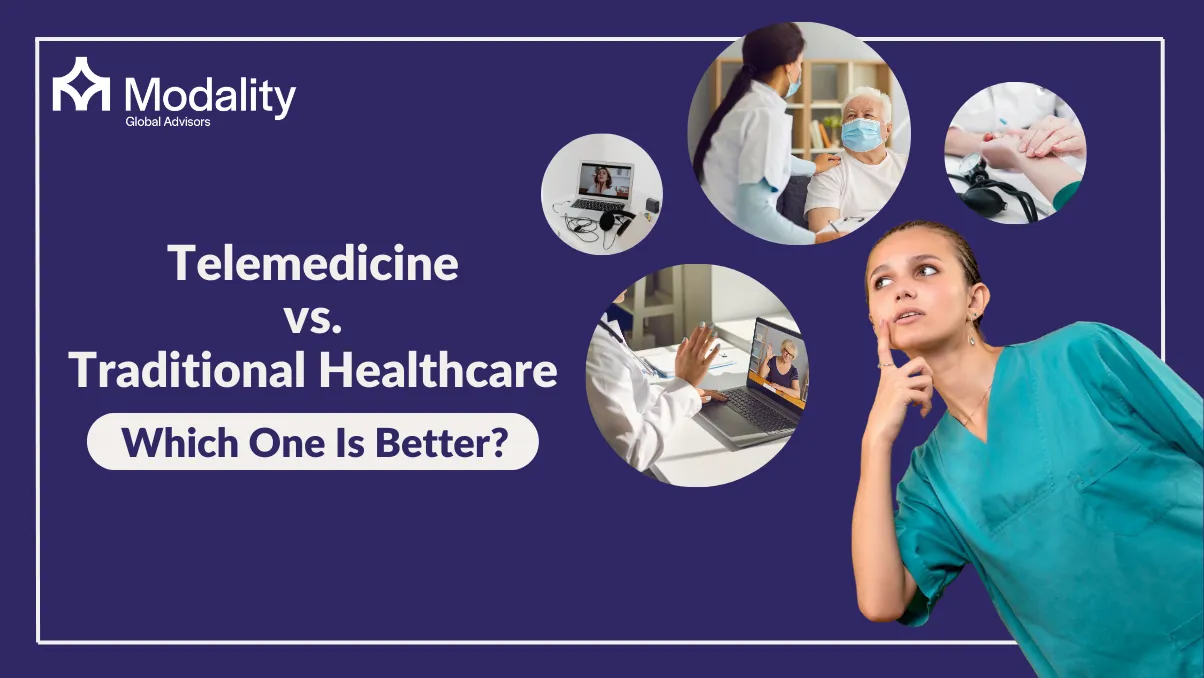The healthcare industry has experienced a significant transformation in recent years, largely driven by technological advancements, rising patient expectations for convenience, and the demand for more efficient care delivery. At the forefront of this shift is the rise of telemedicine, a powerful alternative to traditional in-person care. While both telemedicine and traditional healthcare have their unique strengths and limitations, the choice between them often depends on individual needs, accessibility, and the complexity of medical concerns.
In this blog, we’ll compare these two care models, examine their pros and cons, and highlight how Modality Global Advisors is helping healthcare systems strike the right balance through innovative, integrated solutions.
Scanning the Models
Traditional Healthcare involves face-to-face, physical examinations, diagnostic testing, and direct provider interaction. It is deeply rooted in established clinical protocols and is essential for procedures that require hands-on care.
Telemedicine, on the other hand, uses digital platforms to deliver care remotely. This includes video consultations, mobile health apps, remote patient monitoring, and even AI-driven diagnostics.
Telemedicine vs. Traditional Healthcare: Key Differences
| Model | Telemedicine | Traditional Healthcare |
|---|---|---|
| Accessibility | Available 24/7, ideal for rural areas | Requires physical presence, limited by location |
| Convenience | No travel time, faster consultations | Longer wait times, scheduling required |
| Cost | Often cheaper, reduces overhead expenses | Higher costs (transportation, facility fees) |
| Patient-Doctor Interaction | Virtual, limited physical exams | In-person, better for hands-on diagnosis |
| Emergency Care | Not suitable for life-threatening cases | Essential for emergencies and surgeries |
| Chronic Disease Management | Effective for follow-ups & monitoring | Better for complex, ongoing treatments |
Pros of Telemedicine
- Convenience: Access care from home.
- Reduced Costs: Lower consultation fees and no travel expenses.
- Wider Reach: Bridges gaps for patients in remote areas.
- Faster Appointments: Avoid long waiting room times.
Pros of Traditional Healthcare
- Comprehensive Diagnosis – Physical exams, lab tests, and imaging.
- Better for Emergencies – Immediate care for critical conditions.
- Stronger Patient-Doctor Bond – Face-to-face interactions build trust.
So, Which One Is Better?
There’s no one-size-fits-all answer. Instead, hybrid care models that combine the strengths of both telemedicine and traditional healthcare are emerging as the future of care delivery.
How Modality Global Advisors is Shaping the Future
At Modality Global Advisors (MGA), we believe the future of healthcare isn’t about choosing between telemedicine and traditional care, it’s about integrating both to create a smarter, more responsive system. Our approach helps healthcare organizations blend innovation with established practices to improve outcomes, enhance patient experiences, and streamline operations.
Here’s how we support this transformation:
- Telehealth Readiness & Strategy: Assess infrastructure, patient needs, and clinical workflows to guide telehealth service adoption.
- Integration of Workflow and Development of Hybrid Models: Rework clinical pathways to blend online and in-person services.
- Technology Strategy & Digital Enablement: Guide technology selection and integration for scalable telehealth systems.
- Training & Change Management: Support providers with digital health training to ensure effective telemedicine adoption.
- Compliance & Reimbursement Optimization: Help clients navigate HIPAA, licensure, and payer policies.
- Patient Engagement & Experience Design: Create patient-centric virtual experiences that build trust and satisfaction.
The Future of Healthcare is Hybrid
Telemedicine and traditional healthcare each play a critical role in modern medicine. While telemedicine offers unparalleled convenience and accessibility, traditional in-person care remains essential for managing complex medical conditions. Rather than viewing them as competing models, the future of healthcare depends on a balanced, integrated approach.
Forward-thinking organizations like Modality Global Advisors are leading this shift, helping healthcare systems move from an either/or mindset to a both/and strategy. With the right mix of strategy, technology, and operational alignment, telemedicine and traditional care can work together to deliver high-quality, accessible, and patient-centered care.

